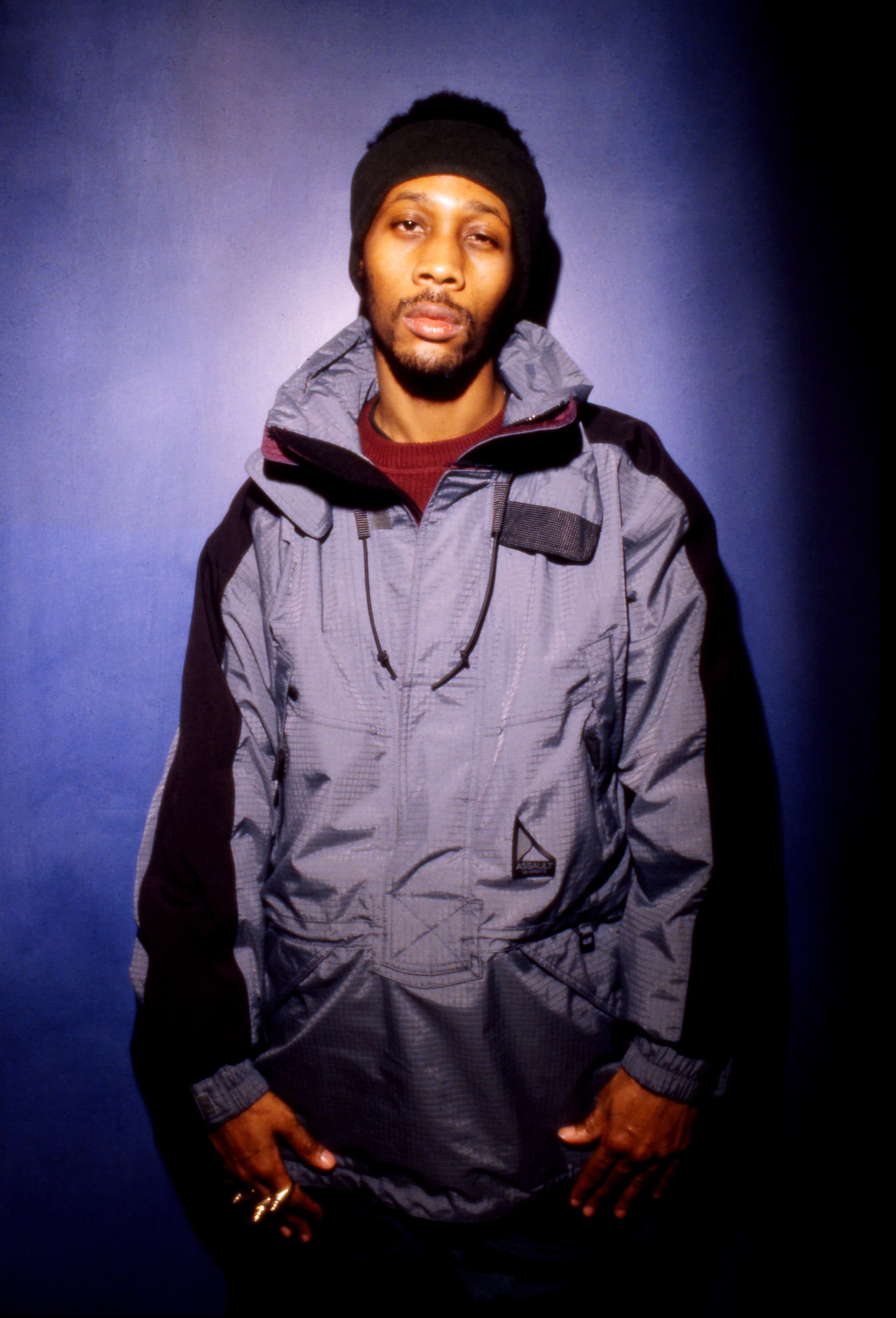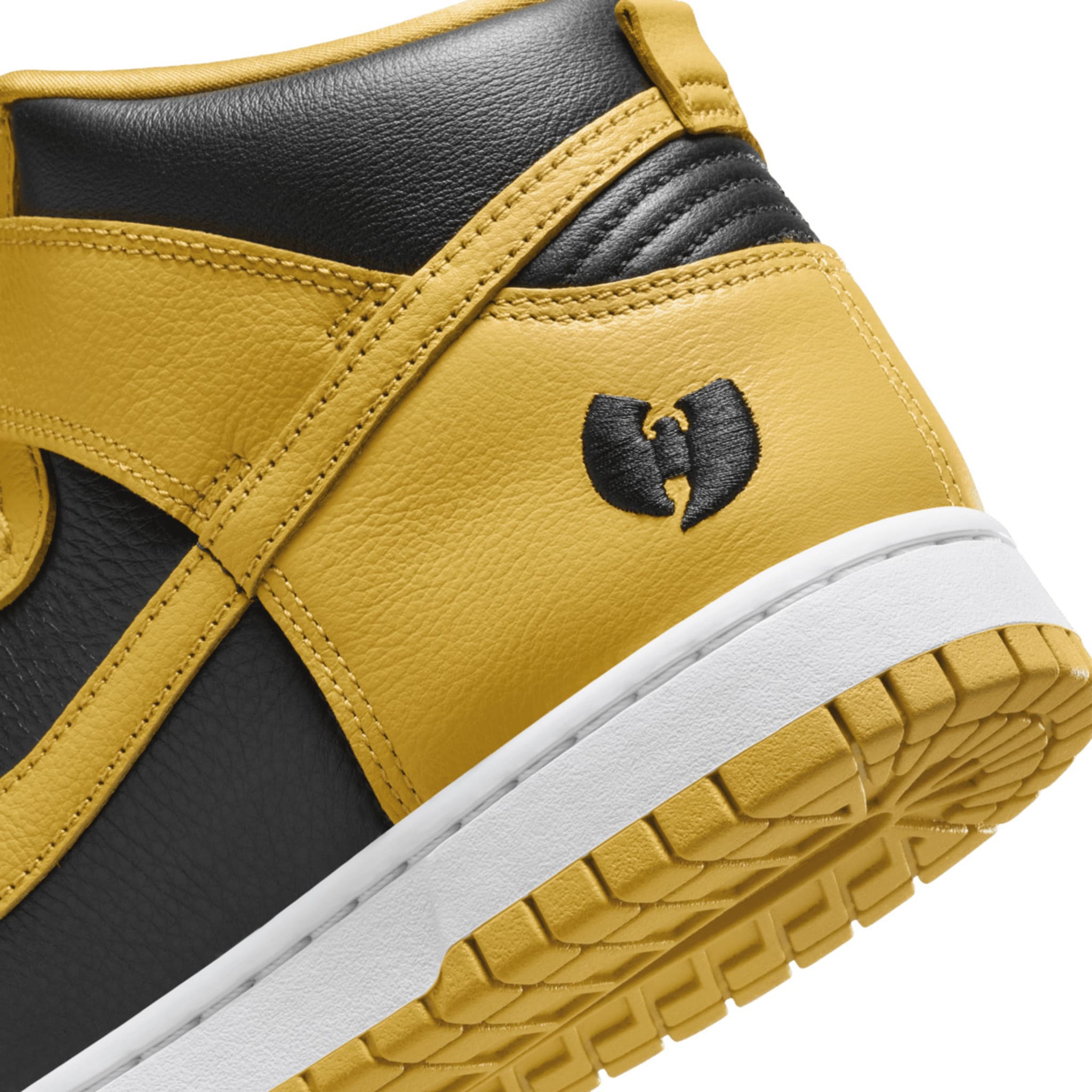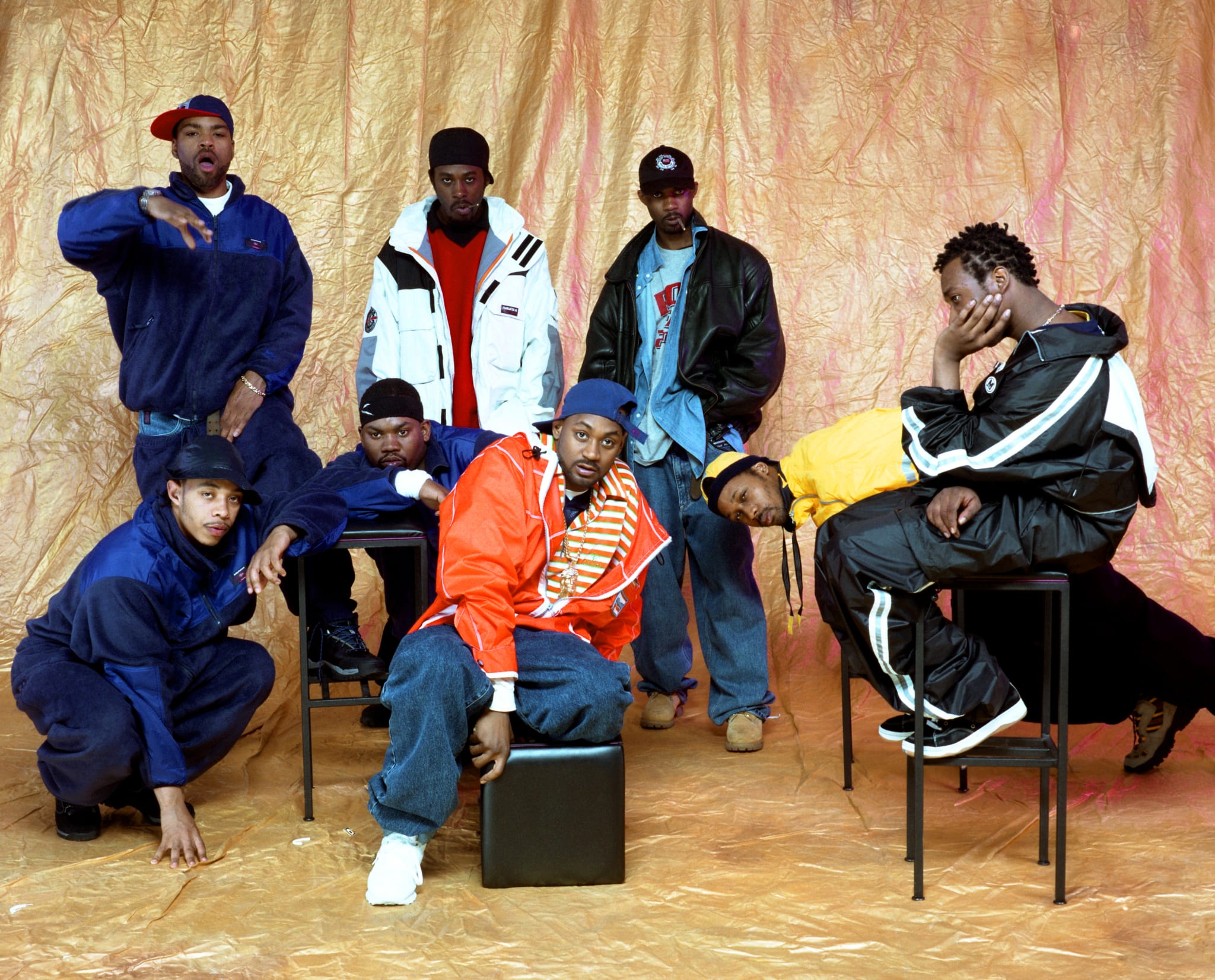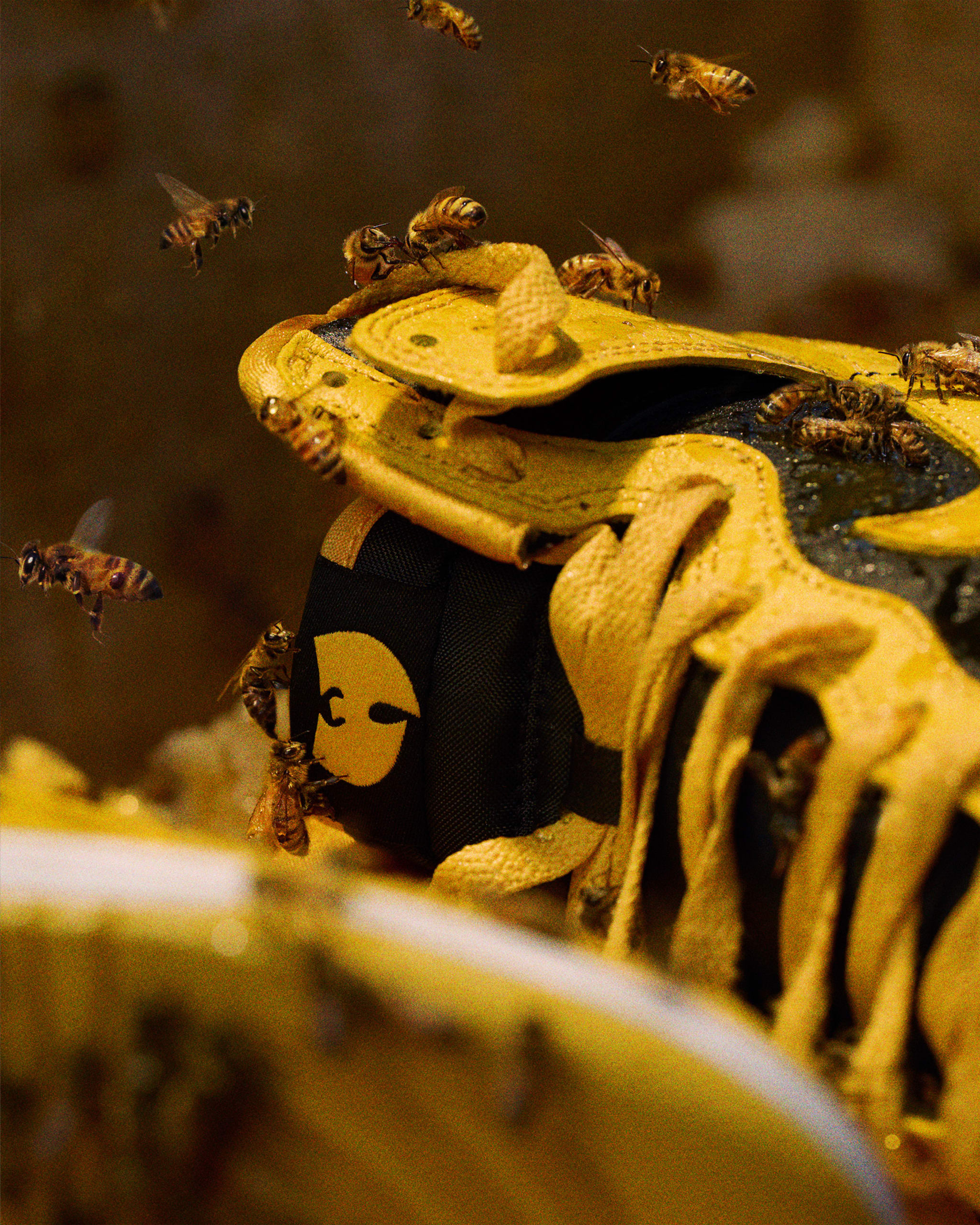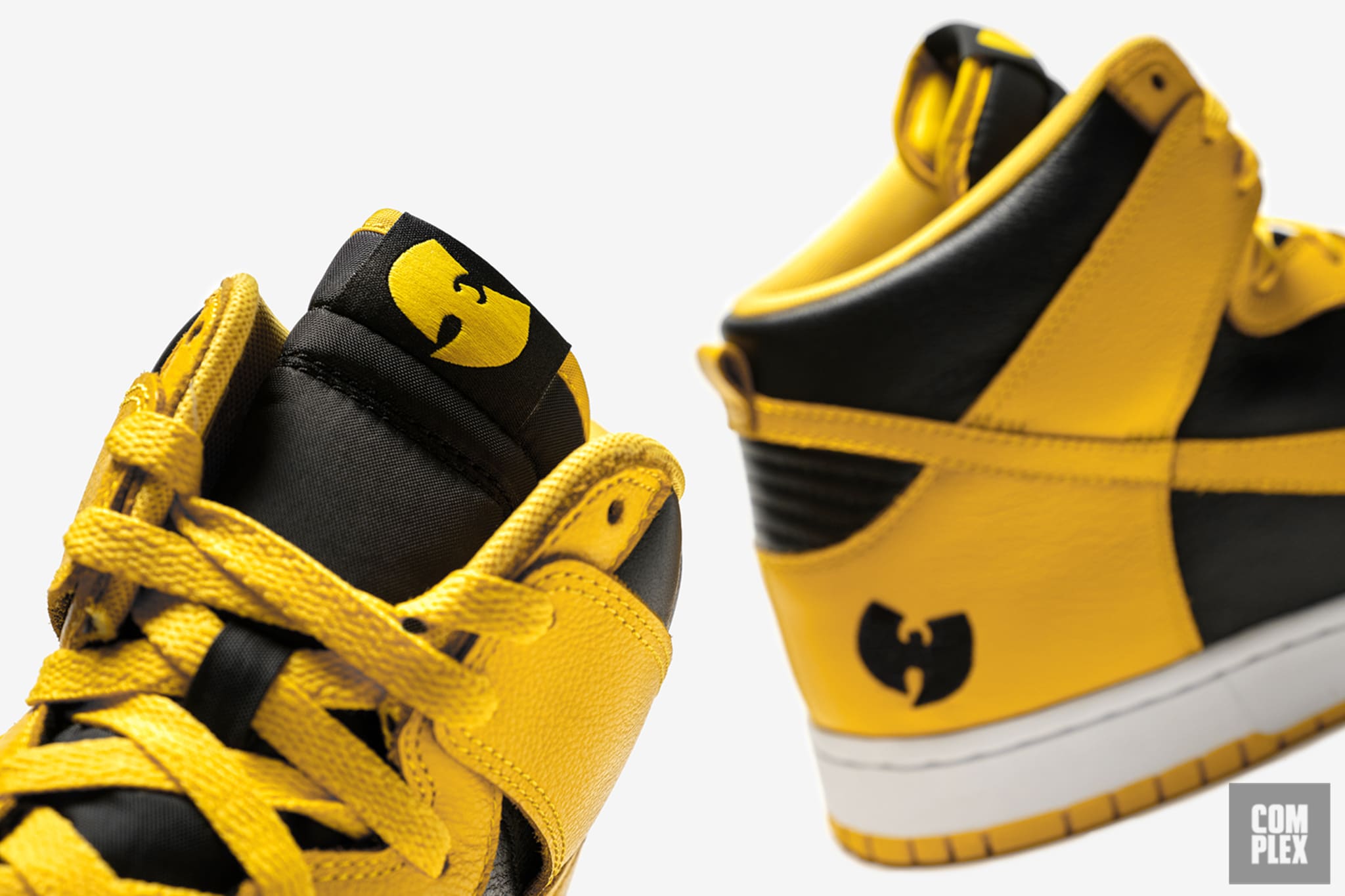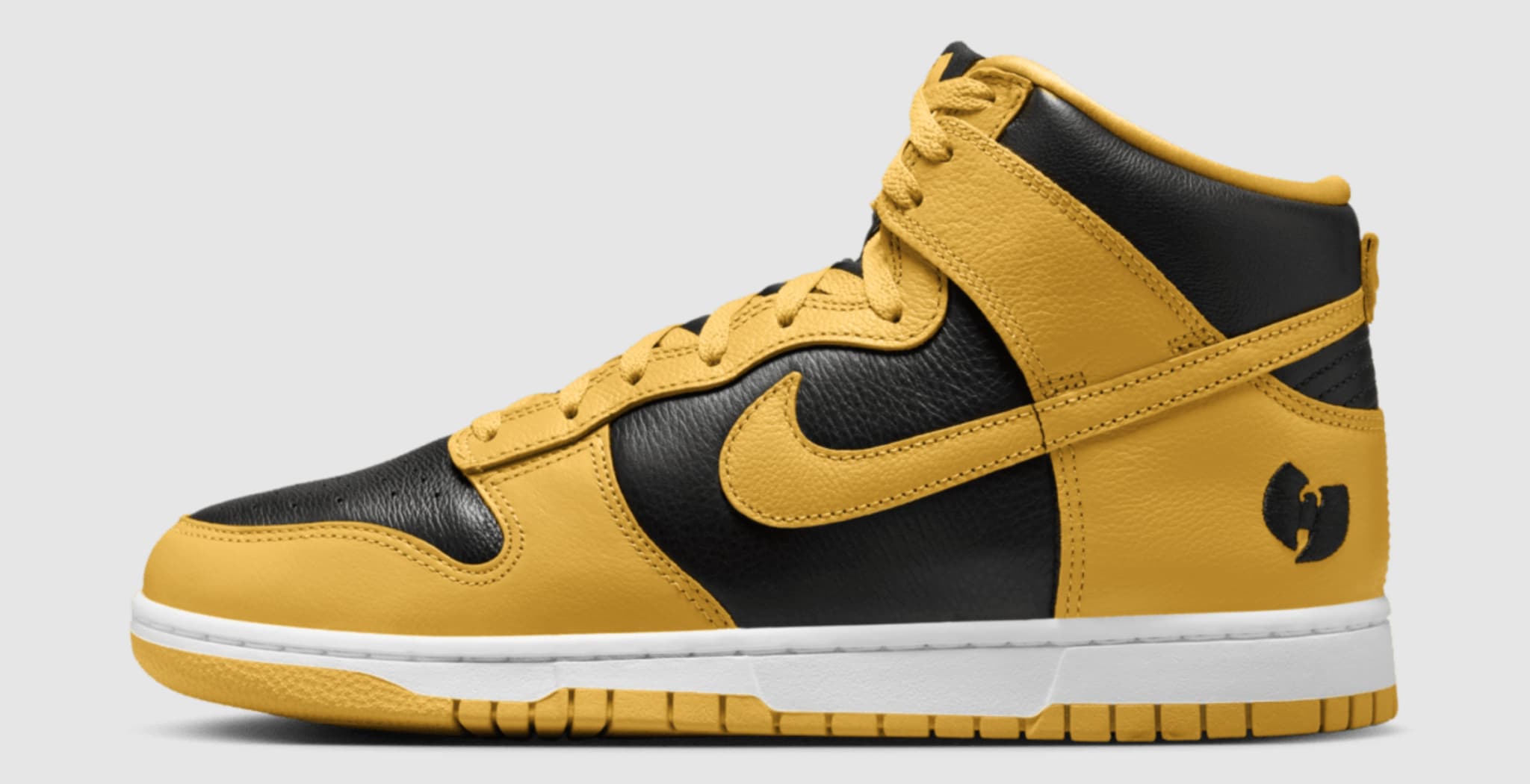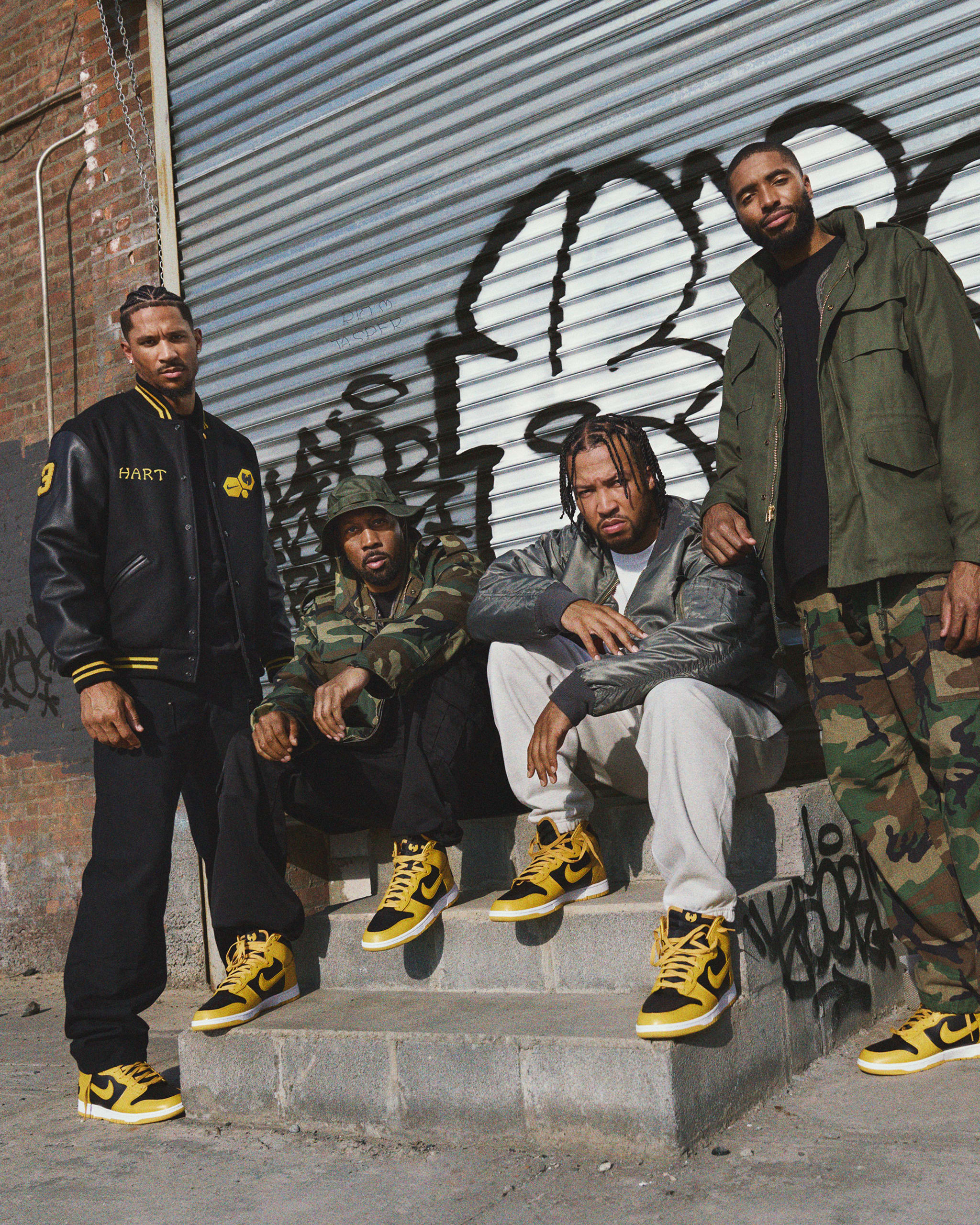Rewrite
The Wu-Tang Clan Nike Dunk was not meant for public consumption. For most of the shoe’s life, the RZA, the producer and leader behind the seminal New York rap group, was fine keeping it that way.
Nike made the sneaker in 1999, using a colorway from the original run of its Dunk silhouette from 1985 as its base and adding the Wu’s iconic emblem on the heel and tongue. The simple use of the logo—a bold, sweeping W that’s been emblazoned on merch, skin, concrete, the cover of your binder in middle school, and every other imaginable canvas—set the shoe apart.
Around 100 pairs of the Wu-Tang Clan x Nike Dunk High were produced then, for promotional use only. The shoe, dressed in bright, shiny yellow and crisp black, became a grail in the decades that followed.
As sneaker reselling evolved in the 2000s, so did the legend of the Wu Dunk, which sold for thousands, and later tens of thousands, of dollars. It was a prototype for the collaboration model as a whole, showing how Nike could tap outside entities to inject new energy into old designs. It was the type of shoe you’d see only on the internet, a sneaker you wanted to own but never could.
Method Man made a public appeal for Nike to bring the shoe back in 2018. When conversations around dropping the Wu Dunk and producing more pairs beyond the promo run from ‘99 would pop up, RZA, who holds the trademark for the group’s logo, would vetoed them. He was totally content with the storied Dunk remaining intangible.
RZA, the leader of the Wu-Tang Clan, holds the trademark to its logo. Via Getty
It wasn’t until he wandered into a StockX dropoff location in Tokyo toward the end of 2023 that the idea of giving the shoe a real release made sense to him. RZA, who was in Japan with his son, didn’t intend to buy anything, but he was curious if StockX, a resale marketplace that specializes in sneakers, could procure the ultra rare Dunk.
StockX did not have any Wu-Tang Dunks on hand, an employee there explained—its storefronts generally don’t have much in the way of physical product—but they could order one of the pairs listed online. For around $100,000.
Right there, in the heart of Shibuya, RZA had an epiphany. Bong bong. If people wanted the shoe that bad, if it meant that much to sneaker culture, perhaps it was right to let them in on it.
“If the value of it is up to there,” RZA concluded, “that means the public may deserve some of that.”
When he got back to America, RZA set the process for a retro in motion. He looped in CAA and Iconic, the talent agencies that represent Wu-Tang Clan. Toward the top of 2024, RZA went to work with Nike, letting the sneaker brand know it was time to bring the Wu Dunk out of the vault. From there, Dave Vericker, a Nike employee who’s quietly orchestrated a number of important releases for the brand, worked behind the scenes on the Wu-Tang collab.
The shoe’s first-ever commercial release is coming next month: Nike will drop the Wu-Tang Dunk High globally on Nov. 9 via its SNKRS app and select retail locations for $150. (The date marks the anniversary of Enter the Wu-Tang (36 Chambers), the group’s debut album.) The 2024 version is based on the 1999 original, but has minor changes: the bee pollen yellow on the upper is darker this time and the logo on the heel sits at a different angle.
This year’s Wu-Tang Dunk uses a darker yellow leather than previous versions. Via Nike
Wu-Tang’s Dunk arrives as part of a wave of re-releases for coveted, expensive Nikes of old that includes September’s rehash of Patta’s “Chlorophyll” Air Max 1 and next year’s retros for the “Galaxy” Foamposite and Undefeated’s unicorn-level Air Jordan 4. The black and yellow Dunk stands out amongst its peers in the category for the longer, twisting path it took to an eventual retail release and its richer mythology.
The Wu-Tang Dunk started at the end of the last century as a clandestine undertaking made outside the bounds of Nike’s typical process, was nearly revived in the 2010s, and is finally being made (somewhat) accessible to sneaker collectors in 2024.
目次
The Original Wu-Tang Dunk From 1999
A promo pair of the first Wu-Tang Nike Dunks from 1999. Via Sotheby’s
The crossover between Nike and the Wu-Tang Clan didn’t have much involvement from the Wu at the onset. The Nike employee responsible for getting Wu-Tang its own sneaker was Drew Greer, a footwear product director for limited-edition styles.
In a 2021 podcast interview with Complex, Greer (who left Nike in 2008) recalled how he devised the Wu Dunk as a means to generate buzz around the Dunk in general, which Nike had just brought back at the end of the ‘90s. Greer knew that Nike was planning a re-release of the black and yellow colorway, which was originally designed as a University of Iowa-themed shoe for Nike’s “Be True to Your School” pack of collegiate Dunks from ‘85. He’d seen that Foot Locker booked around 50,000 pairs of the retro circa ‘99, and felt there wasn’t sufficient demand in the market to justify that many.
“Foot Locker overbought the product. It was oversaturated,” Greer told Complex in 2017. “We had the Iowa coming. I knew it was a challenging colorway, but we were trying to find a way to build energy around the product in a creative way.”
Greer got a solution from Come Chantrel, a tastemaking employee at Wu’s label, Loud Records. One afternoon at the Loud Offices in New York, Chantrel suggested they get the Wu-Tang mark on a pair of Dunks. The Iowa combo of black and yellow was already a perfect match for the Wu’s killa bee color scheme. Loud approved the idea.
Members of the Wu-Tang Clan in 1997. Via Getty
Chantrel worked with Loud founder Steve Rifkind to get the clearance to use the Wu logo. Udi Avshalom, the New York sneaker retail power broker who started the store Training Camp and was connected with Wu-Tang, was involved in the Dunk, too. RZA was not close to the project.
“I had no creative involvement,” RZA said of the first Wu Dunk in an episode of the Complex Sneakers Show that was released Friday. “I just let it roll.”
He remembered signing off on the shoe but never signing an actual piece of paper to legally authorize it. RZA was more loose with the Wu’s intellectual property back then. He saw moments like the Dunk as promotional opportunities rather than opportunities for profit.
“I didn’t really do no business with it,” RZA said of the Dunk, “meaning there was no economic business to the company for it. It was more like a cultural thing and a marketing thing.”
Nike didn’t make money off the sneakers either—at least not directly. The Wu Dunk cost the company time and resources to produce, but Nike didn’t recoup its investment by selling the shoes. The sneakers were seeded out to Wu-Tang Clan members and Nike friends and family for free.
“It wasn’t a retail deal,” Greer said. “It was something where we did 100 pair. I kept 50, they kept 50.”
The 2024 Wu-Tang Dunk. Via Nike
He never talked to anyone from Wu-Tang while working on the sneaker. Nike’s entertainment marketing department was territorial, Greer said, and kept a distance between entertainers and the people who made the shoes for them. It also didn’t want to open the floodgates and invite other artists to come asking for their own sneakers.
“Our entertainment marketing department didn’t want to take on responsibility doing specific product for artists,” Greer said. “I stepped outside of my bounds and got a warning, but I was trying to build my business.”
That earliest Wu-Tang x Nike Dunk High didn’t add to Nike’s bottom line, but it added to the mystique of the Dunk, a shoe Nike turbocharged in the 21st century by regularly cooking up similar collaborations. Shoes like the “Pigeon” SB Dunks by Staple and the De La Soul SB Dunks were made possible by the precedent set by Wu’s Dunk. Those pairs, and the hype they sustained in the aftermarket, established a cottage industry fed by addicts eager to fork over their money for the next scarce sneaker with a logo stamp. If Greer got a warning then, he’s probably deserving of a medal from Nike now.
The 2016 Wu-Tang Dunk That Never Happened
Nike tried to remake the Wu-Tang Dunk in the 2010s, but the shoe never released. Via Complex
Nike ignited a craze around the Dunk in the 2000s by pumping out bold variants in small quantities. There were Dunks in flashy colors, Dunks with intricately designed uppers of wavy lines etched by lasers, Dunks that were so hyper limited they seemed to not exist at all. Part of what made them so compelling was the notion that you might only ever have one chance to buy any given pair and that was it—these shoes weren’t likely to ever come back. The Wu-Tang Dunk High was one of these, a shoe that was inaccessible at first because of the nature of its creation, and later because keeping it that way served to preserve its aura.
It was a shoe that Nike—or at least a few people at Nike—tried to make happen again in the leadup to the 25th anniversary of the Wu-Tang Clan’s debut album.
“We were gonna do a 25th anniversary drop in 2018 for Enter the 36 Chambers,” said one former Nike employee who worked on a Wu Dunk retro that never came to fruition. “Samples were in process, but Nike entertainment marketing couldn’t get the deal done.”
The former Nike employee spoke with Complex on the condition of anonymity as they did not have authorization to discuss the unreleased Wu shoe. They said that the plan was to make 360 new pairs in the same black and yellow colorblocking as the ‘99 Dunk, along with an additional batch of 36 in the reverse colors.
The Wu-Tang logo on the tongue and heel of the unreleased 2016 Dunk. Via Complex
They tweaked the materials, seeking to improve upon the promo-only Wu Dunk. Unlike the original, the release intended for 2018 was to use full-grain leather.
“There is a wrinkle to the leather that comes from using quality leather,” the former Nike employee said, “and not that polyurethane coated bullshit Nike puts on everything.”
Nike was working on that iteration of the shoe well before the anniversary year, so the sample tags on some pairs that made it out to the wild read “Spring ‘16.” The tags refer to the shoe as the “Ancient Monk” Dunk, a codename Nike invented that evoked the kung-flu flair of the Wu brand without tipping off potential leakers prying for info about future Nike shoes.
The former Nike employee said the design was done, but that Nike couldn’t get clearance from the Wu-Tang Clan. Nike, having already done the work of remaking the Wu Dunk, shelved the reissue.
“I vetoed,” RZA told Complex. “I wasn’t ready to do it.”
The secondary market was ready, though. While Nike couldn’t drop the shoe, it had already produced a handful. They made their way off Nike’s campus in Beaverton, Oregon, landing at consignment shops and in the hands of collectors. In 2022, one ex-Nike employee sold a personal pair they kept for $25,000 cash. Los Angeles-based resale shop Rif had a pair listed for $50,000 in 2023—it eventually sold for $20,000 when the seller caught wind the shoe was coming back.
Then came the fakes. A shoe that could fetch so much money was an easy target for counterfeiters, who had a sizable financial incentive to make Wu Dunks that looked as legit as possible, even if Nike didn’t OK their production. By one collector’s estimate, more than a hundred pairs of unauthorized “samples” purporting to be from the same batch as the legit samples were circulating.
If you wanted a pair of Wu-Tang x Nike Dunk Highs at that point, in the late 2010s, your options were costly and risky. If you could manage to find an original pair in your size, it might cost you $40,000. Even if you wanted the aborted retro that was made in small numbers around 2016, you were going to be paying thousands, and accepting the chance that you might be paying thousands for a fraudulent pair. The mythical Wu Dunk, which nearly came back from the dead, looked all but extinct.
In 2024, the Wu-Tang Dunk Finally Returns
The 2024 Wu-Tang Dunk will mark the shoe’s first public release. Via Nike
Given how long it was in limbo, it felt unlikely before this year that the Wu-Tang Dunk would ever see a commercial release, no matter how much people at Nike wanted it to happen.
“It’s been almost 10 years of this same conversation,” RZA said. “I never, as the trademark holder, never wanted to do it again.”
That he’s acquiesced, that RZA feels now is the right time for a retro, is a boon for Nike. The sneaker brand is in a slump; sales are down and the flow of exciting Nike product has slowed. The Dunk as a model is simmering after being red hot in the early 2020s, when Nike relentlessly churned out mass-produced batches of Dunks. Now, Nike plans to make less Dunks going forward to protect their cool. But it still needs heat around the shoe, if in controlled doses.
So this year’s Wu-Tang x Nike Dunk High will be available for the public, but not too easy to get. You won’t have to pay $100,000 to get a pair anymore, but you will have to make some effort to track the shoe down. (Or pay around $460, which is the average going price for early pairs on StockX now.) The tactic, one Nike’s worked on perfecting for decades, is to carefully balance the supply and demand so that the sneaker is special without being totally unattainable.
“Let’s share this,” RZA said, “but it’s still limited.”
Nike tapped New York Knicks Josh Hart, Jalen Brunson, and Mikal Bridges for a campaign around the 2024 Wu-Tang Dunk. Via Nike
RZA told Complex that he didn’t know off the top of his head how many pairs of the retro Nike made, and Nike doesn’t disclose numbers on production runs. The original ‘99 Wu Dunk has become so hard to find that even Nike doesn’t have the shoe in its archives. When Nike recreated the shoe, it had to borrow a pair from sneaker collector Mark “Mayor” Farese.
In making the new Wu Dunk a reality, RZA wanted to cut in other members of the Wu-Tang Clan and get them paid. RZA felt that the rappers who make up the group deserved to reap the benefits of a Nike shoe bearing the logo they helped make ubiquitous. Even if the decision of what to do with that logo ultimately lies with him.
“I don’t have to consult when it comes to the trademark,” RZA said. “I do, though.”
The return of the Wu-Tang Dunk, and Nike’s wider strategy of giving the masses another chance at cult classics, has not been universally accepted as a good thing. The practice has provoked some sanctimonious questioning about whether sacred, elusive shoes should stay that way. Is it right to release the Wu Dunk after all these years? Should something that was a treasure for so long be made more common? For his part, RZA has no doubt.
“If it brings joy,” the Wu leader said, “or brings something of value to a consumer, he should have access to it.”
Related
in HTML format, including tags, to make it appealing and easy to read for Japanese-speaking readers aged 20 to 40 interested in fashion. Organize the content with appropriate headings and subheadings (h1, h2, h3, h4, h5, h6), translating all text, including headings, into Japanese. Retain any existing
tags from
The Wu-Tang Clan Nike Dunk was not meant for public consumption. For most of the shoe’s life, the RZA, the producer and leader behind the seminal New York rap group, was fine keeping it that way.
Nike made the sneaker in 1999, using a colorway from the original run of its Dunk silhouette from 1985 as its base and adding the Wu’s iconic emblem on the heel and tongue. The simple use of the logo—a bold, sweeping W that’s been emblazoned on merch, skin, concrete, the cover of your binder in middle school, and every other imaginable canvas—set the shoe apart.
Around 100 pairs of the Wu-Tang Clan x Nike Dunk High were produced then, for promotional use only. The shoe, dressed in bright, shiny yellow and crisp black, became a grail in the decades that followed.
As sneaker reselling evolved in the 2000s, so did the legend of the Wu Dunk, which sold for thousands, and later tens of thousands, of dollars. It was a prototype for the collaboration model as a whole, showing how Nike could tap outside entities to inject new energy into old designs. It was the type of shoe you’d see only on the internet, a sneaker you wanted to own but never could.
Method Man made a public appeal for Nike to bring the shoe back in 2018. When conversations around dropping the Wu Dunk and producing more pairs beyond the promo run from ‘99 would pop up, RZA, who holds the trademark for the group’s logo, would vetoed them. He was totally content with the storied Dunk remaining intangible.
RZA, the leader of the Wu-Tang Clan, holds the trademark to its logo. Via Getty
It wasn’t until he wandered into a StockX dropoff location in Tokyo toward the end of 2023 that the idea of giving the shoe a real release made sense to him. RZA, who was in Japan with his son, didn’t intend to buy anything, but he was curious if StockX, a resale marketplace that specializes in sneakers, could procure the ultra rare Dunk.
StockX did not have any Wu-Tang Dunks on hand, an employee there explained—its storefronts generally don’t have much in the way of physical product—but they could order one of the pairs listed online. For around $100,000.
Right there, in the heart of Shibuya, RZA had an epiphany. Bong bong. If people wanted the shoe that bad, if it meant that much to sneaker culture, perhaps it was right to let them in on it.
“If the value of it is up to there,” RZA concluded, “that means the public may deserve some of that.”
When he got back to America, RZA set the process for a retro in motion. He looped in CAA and Iconic, the talent agencies that represent Wu-Tang Clan. Toward the top of 2024, RZA went to work with Nike, letting the sneaker brand know it was time to bring the Wu Dunk out of the vault. From there, Dave Vericker, a Nike employee who’s quietly orchestrated a number of important releases for the brand, worked behind the scenes on the Wu-Tang collab.
The shoe’s first-ever commercial release is coming next month: Nike will drop the Wu-Tang Dunk High globally on Nov. 9 via its SNKRS app and select retail locations for $150. (The date marks the anniversary of Enter the Wu-Tang (36 Chambers), the group’s debut album.) The 2024 version is based on the 1999 original, but has minor changes: the bee pollen yellow on the upper is darker this time and the logo on the heel sits at a different angle.
This year’s Wu-Tang Dunk uses a darker yellow leather than previous versions. Via Nike
Wu-Tang’s Dunk arrives as part of a wave of re-releases for coveted, expensive Nikes of old that includes September’s rehash of Patta’s “Chlorophyll” Air Max 1 and next year’s retros for the “Galaxy” Foamposite and Undefeated’s unicorn-level Air Jordan 4. The black and yellow Dunk stands out amongst its peers in the category for the longer, twisting path it took to an eventual retail release and its richer mythology.
The Wu-Tang Dunk started at the end of the last century as a clandestine undertaking made outside the bounds of Nike’s typical process, was nearly revived in the 2010s, and is finally being made (somewhat) accessible to sneaker collectors in 2024.
The Original Wu-Tang Dunk From 1999
A promo pair of the first Wu-Tang Nike Dunks from 1999. Via Sotheby’s
The crossover between Nike and the Wu-Tang Clan didn’t have much involvement from the Wu at the onset. The Nike employee responsible for getting Wu-Tang its own sneaker was Drew Greer, a footwear product director for limited-edition styles.
In a 2021 podcast interview with Complex, Greer (who left Nike in 2008) recalled how he devised the Wu Dunk as a means to generate buzz around the Dunk in general, which Nike had just brought back at the end of the ‘90s. Greer knew that Nike was planning a re-release of the black and yellow colorway, which was originally designed as a University of Iowa-themed shoe for Nike’s “Be True to Your School” pack of collegiate Dunks from ‘85. He’d seen that Foot Locker booked around 50,000 pairs of the retro circa ‘99, and felt there wasn’t sufficient demand in the market to justify that many.
“Foot Locker overbought the product. It was oversaturated,” Greer told Complex in 2017. “We had the Iowa coming. I knew it was a challenging colorway, but we were trying to find a way to build energy around the product in a creative way.”
Greer got a solution from Come Chantrel, a tastemaking employee at Wu’s label, Loud Records. One afternoon at the Loud Offices in New York, Chantrel suggested they get the Wu-Tang mark on a pair of Dunks. The Iowa combo of black and yellow was already a perfect match for the Wu’s killa bee color scheme. Loud approved the idea.
Members of the Wu-Tang Clan in 1997. Via Getty
Chantrel worked with Loud founder Steve Rifkind to get the clearance to use the Wu logo. Udi Avshalom, the New York sneaker retail power broker who started the store Training Camp and was connected with Wu-Tang, was involved in the Dunk, too. RZA was not close to the project.
“I had no creative involvement,” RZA said of the first Wu Dunk in an episode of the Complex Sneakers Show that was released Friday. “I just let it roll.”
He remembered signing off on the shoe but never signing an actual piece of paper to legally authorize it. RZA was more loose with the Wu’s intellectual property back then. He saw moments like the Dunk as promotional opportunities rather than opportunities for profit.
“I didn’t really do no business with it,” RZA said of the Dunk, “meaning there was no economic business to the company for it. It was more like a cultural thing and a marketing thing.”
Nike didn’t make money off the sneakers either—at least not directly. The Wu Dunk cost the company time and resources to produce, but Nike didn’t recoup its investment by selling the shoes. The sneakers were seeded out to Wu-Tang Clan members and Nike friends and family for free.
“It wasn’t a retail deal,” Greer said. “It was something where we did 100 pair. I kept 50, they kept 50.”
The 2024 Wu-Tang Dunk. Via Nike
He never talked to anyone from Wu-Tang while working on the sneaker. Nike’s entertainment marketing department was territorial, Greer said, and kept a distance between entertainers and the people who made the shoes for them. It also didn’t want to open the floodgates and invite other artists to come asking for their own sneakers.
“Our entertainment marketing department didn’t want to take on responsibility doing specific product for artists,” Greer said. “I stepped outside of my bounds and got a warning, but I was trying to build my business.”
That earliest Wu-Tang x Nike Dunk High didn’t add to Nike’s bottom line, but it added to the mystique of the Dunk, a shoe Nike turbocharged in the 21st century by regularly cooking up similar collaborations. Shoes like the “Pigeon” SB Dunks by Staple and the De La Soul SB Dunks were made possible by the precedent set by Wu’s Dunk. Those pairs, and the hype they sustained in the aftermarket, established a cottage industry fed by addicts eager to fork over their money for the next scarce sneaker with a logo stamp. If Greer got a warning then, he’s probably deserving of a medal from Nike now.
The 2016 Wu-Tang Dunk That Never Happened
Nike tried to remake the Wu-Tang Dunk in the 2010s, but the shoe never released. Via Complex
Nike ignited a craze around the Dunk in the 2000s by pumping out bold variants in small quantities. There were Dunks in flashy colors, Dunks with intricately designed uppers of wavy lines etched by lasers, Dunks that were so hyper limited they seemed to not exist at all. Part of what made them so compelling was the notion that you might only ever have one chance to buy any given pair and that was it—these shoes weren’t likely to ever come back. The Wu-Tang Dunk High was one of these, a shoe that was inaccessible at first because of the nature of its creation, and later because keeping it that way served to preserve its aura.
It was a shoe that Nike—or at least a few people at Nike—tried to make happen again in the leadup to the 25th anniversary of the Wu-Tang Clan’s debut album.
“We were gonna do a 25th anniversary drop in 2018 for Enter the 36 Chambers,” said one former Nike employee who worked on a Wu Dunk retro that never came to fruition. “Samples were in process, but Nike entertainment marketing couldn’t get the deal done.”
The former Nike employee spoke with Complex on the condition of anonymity as they did not have authorization to discuss the unreleased Wu shoe. They said that the plan was to make 360 new pairs in the same black and yellow colorblocking as the ‘99 Dunk, along with an additional batch of 36 in the reverse colors.
The Wu-Tang logo on the tongue and heel of the unreleased 2016 Dunk. Via Complex
They tweaked the materials, seeking to improve upon the promo-only Wu Dunk. Unlike the original, the release intended for 2018 was to use full-grain leather.
“There is a wrinkle to the leather that comes from using quality leather,” the former Nike employee said, “and not that polyurethane coated bullshit Nike puts on everything.”
Nike was working on that iteration of the shoe well before the anniversary year, so the sample tags on some pairs that made it out to the wild read “Spring ‘16.” The tags refer to the shoe as the “Ancient Monk” Dunk, a codename Nike invented that evoked the kung-flu flair of the Wu brand without tipping off potential leakers prying for info about future Nike shoes.
The former Nike employee said the design was done, but that Nike couldn’t get clearance from the Wu-Tang Clan. Nike, having already done the work of remaking the Wu Dunk, shelved the reissue.
“I vetoed,” RZA told Complex. “I wasn’t ready to do it.”
The secondary market was ready, though. While Nike couldn’t drop the shoe, it had already produced a handful. They made their way off Nike’s campus in Beaverton, Oregon, landing at consignment shops and in the hands of collectors. In 2022, one ex-Nike employee sold a personal pair they kept for $25,000 cash. Los Angeles-based resale shop Rif had a pair listed for $50,000 in 2023—it eventually sold for $20,000 when the seller caught wind the shoe was coming back.
Then came the fakes. A shoe that could fetch so much money was an easy target for counterfeiters, who had a sizable financial incentive to make Wu Dunks that looked as legit as possible, even if Nike didn’t OK their production. By one collector’s estimate, more than a hundred pairs of unauthorized “samples” purporting to be from the same batch as the legit samples were circulating.
If you wanted a pair of Wu-Tang x Nike Dunk Highs at that point, in the late 2010s, your options were costly and risky. If you could manage to find an original pair in your size, it might cost you $40,000. Even if you wanted the aborted retro that was made in small numbers around 2016, you were going to be paying thousands, and accepting the chance that you might be paying thousands for a fraudulent pair. The mythical Wu Dunk, which nearly came back from the dead, looked all but extinct.
In 2024, the Wu-Tang Dunk Finally Returns
The 2024 Wu-Tang Dunk will mark the shoe’s first public release. Via Nike
Given how long it was in limbo, it felt unlikely before this year that the Wu-Tang Dunk would ever see a commercial release, no matter how much people at Nike wanted it to happen.
“It’s been almost 10 years of this same conversation,” RZA said. “I never, as the trademark holder, never wanted to do it again.”
That he’s acquiesced, that RZA feels now is the right time for a retro, is a boon for Nike. The sneaker brand is in a slump; sales are down and the flow of exciting Nike product has slowed. The Dunk as a model is simmering after being red hot in the early 2020s, when Nike relentlessly churned out mass-produced batches of Dunks. Now, Nike plans to make less Dunks going forward to protect their cool. But it still needs heat around the shoe, if in controlled doses.
So this year’s Wu-Tang x Nike Dunk High will be available for the public, but not too easy to get. You won’t have to pay $100,000 to get a pair anymore, but you will have to make some effort to track the shoe down. (Or pay around $460, which is the average going price for early pairs on StockX now.) The tactic, one Nike’s worked on perfecting for decades, is to carefully balance the supply and demand so that the sneaker is special without being totally unattainable.
“Let’s share this,” RZA said, “but it’s still limited.”
Nike tapped New York Knicks Josh Hart, Jalen Brunson, and Mikal Bridges for a campaign around the 2024 Wu-Tang Dunk. Via Nike
RZA told Complex that he didn’t know off the top of his head how many pairs of the retro Nike made, and Nike doesn’t disclose numbers on production runs. The original ‘99 Wu Dunk has become so hard to find that even Nike doesn’t have the shoe in its archives. When Nike recreated the shoe, it had to borrow a pair from sneaker collector Mark “Mayor” Farese.
In making the new Wu Dunk a reality, RZA wanted to cut in other members of the Wu-Tang Clan and get them paid. RZA felt that the rappers who make up the group deserved to reap the benefits of a Nike shoe bearing the logo they helped make ubiquitous. Even if the decision of what to do with that logo ultimately lies with him.
“I don’t have to consult when it comes to the trademark,” RZA said. “I do, though.”
The return of the Wu-Tang Dunk, and Nike’s wider strategy of giving the masses another chance at cult classics, has not been universally accepted as a good thing. The practice has provoked some sanctimonious questioning about whether sacred, elusive shoes should stay that way. Is it right to release the Wu Dunk after all these years? Should something that was a treasure for so long be made more common? For his part, RZA has no doubt.
“If it brings joy,” the Wu leader said, “or brings something of value to a consumer, he should have access to it.”
Related
and integrate them seamlessly into the new content without adding new tags. Ensure the new content is fashion-related, written entirely in Japanese, and approximately 1500 words. Conclude with a “結論” section and a well-formatted “よくある質問” section. Avoid including an introduction or a note explaining the process.

